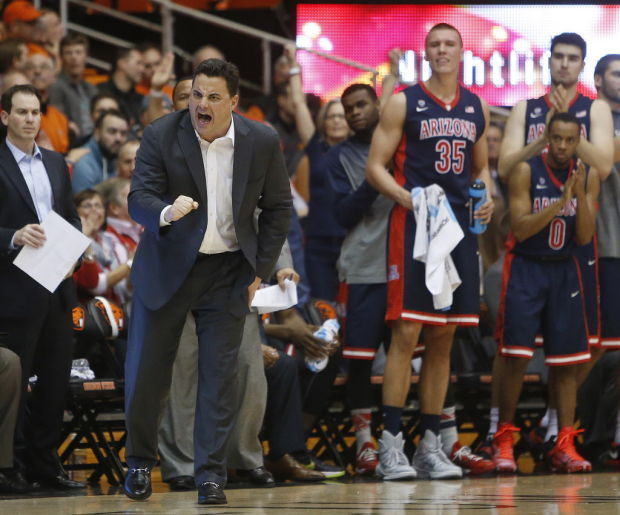The average college basketball Joe wearing earmuffs in Council Bluffs, Iowa, was long asleep when Oregon State bedazzled defenseless Arizona on Sunday night.
It won’t hit him until spring, when he studies his March Madness bracket and notices that one of Arizona’s five losses was to the Beavers.
“Hey, Edith,” he’ll say, “did you know Arizona lost at Oregon State?”
“Are they the Ducks?” his wife will answer.
It won’t matter much then, and it doesn’t matter much now.
The most sage perspective on college basketball I’ve heard came from Duke’s well-traveled Mike Krzyzewski, who said, “Some years you lose in the first round.”
Some years you lose at Gill Coliseum.
As far as I can discern, the worst Pac-12 team to beat the modern-era Wildcats was the 1994 Washington Huskies, who finished 5-22 and had lost nine straight when No. 12 Arizona arrived at old Hec Ed Pavilion.
To that point, the 2-15 Huskies had only beaten Idaho and Pacific.
Arizona lost 74-69.
Two months later, the Cats were in the Final Four.
The Beavers are so juiced about chopping up Sean Miller’s team that they produced a happy video and linked it to the global satellite system. (The UA does about 10 of those per season.)
Just a wild guess, but I’m thinking that’s the first basketball video the beleaguered Beavers ever created for mass distribution.
Such is life on the road.
Oregon State might now have difficulty explaining its early-season loss at Quinnipiac. (Or, more penetrating — what was it doing scheduling a game at Quinnipiac?)
The Beavers have their Quinnipiac. The Wildcats have their Beavers.
What is most troubling about Arizona’s brief loss of basketball consciousness Sunday was how it rolled over in the final 93 seconds.
Miller’s defensive reputation precedes the Wildcats wherever they go. On the rare night they can’t shoot straight, they’ve generally been able to win implementing Miller’s “pack-line defense,” which is a coach’s code for “you’re never going to get an open shot.”
But with 1:33 remaining, trailing 53-52, Miller didn’t have his pack-line personnel on the floor. Center Kaleb Tarczewski and forward Brandon Ashley, both of who played ineffectively, were on the bench.
There was no rim protection, which is the hallmark of Arizona’s defense.
OSU sophomore Malcolm Duvivier, which is French for “I’m shooting 35.1 percent this year,” was matched one-on-one against the UA’s most feared defensive player, Rondae Hollis-Jefferson.
Going to his left, Duvivier beat RHJ off the dribble and then to the basket. There was no inside help. Not only did Duvivier score, he was fouled and made the free throw.
Worse, after Arizona tied it at 56, the Beavers’ Langston Morris-Walker scored the deciding basket against a ghost defense.
He beat Stanley Johnson off the dribble — Johnson all but moved aside to make it easy for Morris-Walker — and the avenue to the basket was unimpeded.
It was puzzling to see Miller go down without his staple defensive strategy.
The concept of a pack-line defense is simple: encourage dribble-penetration into your interior — that’s why Aaron Gordon was so valuable — forcing contested jumpers in traffic.
Usually, every opposing ball handler who tries to penetrate late in a close game is greeted by UA’s “pack,” and sees three men in red and blue.
On Sunday night, as Morris-Walker scored the winner, the man closest to him was 6-foot T.J. McConnell. Morris-Walker saw nothing but glory.
And now you know why Gordon and Nick Johnson, who were probably the Pac-12’s two leading defensive players a year ago, were so indispensable.
A year ago, there’s no way Duvivier and Morris-Walker score on ucontested layups in the game’s final 93 seconds. Sure UA shot poorly Sunday (37.8 percent), but it shot worse than that against San Diego State (36.5) and won, and it shot worse than that a year ago at Stanford (37.5) and prevailed.
But without Gordon and Johnson running the pack, the game is changing. Arizona’s defensive personnel isn’t as fearsome or capable.
The Beavers did what most outmanned teams do against UA: go slow. Arizona attempted just 45 shots at Gill Coliseum; it averages 53.
When you kill the clock like OSU did, and sabotage Arizona’s offense, you’ve got a chance. The template for upsetting the Wildcats was established a year ago.
At the end of regulation, Arizona’s most painful losses last season had the following scores:
51-51 at ASU.
54-54 vs. Wisconsin.
60-58 at Cal.
Give Oregon State coach Wayne Tinkle credit for doing his homework. With an extra day to scheme between games, he found a way for percentage-challenged shooters Morris-Walker (38.4 percent) and Duvivier (35.1) to get open shots when it mattered most.
Even those guys didn’t miss from 2 feet out.





